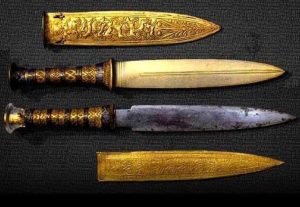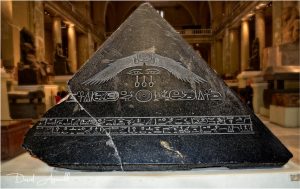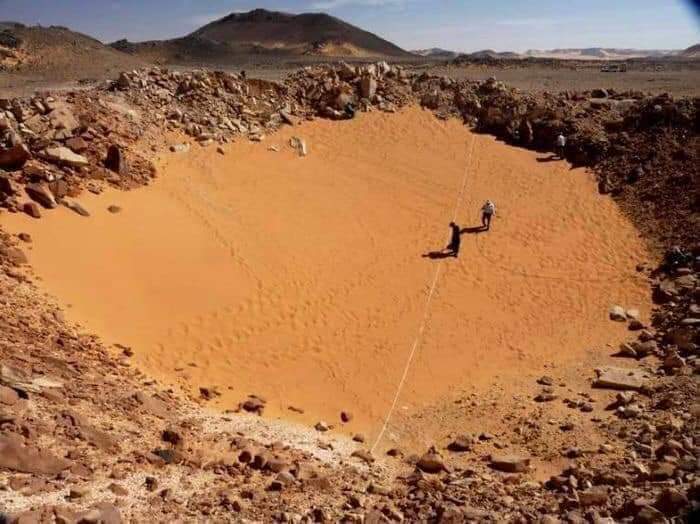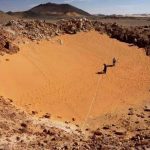The Meteoritic Mystery of the Pharaonic History.
Where Do Stone Meteorites Come From???
Most meteorites that have fallen upon our planet originated within the Asteroid Belt, which lies between Mars and the gas giant Jupiter.
A comparatively small number of meteorites are known to have come to us from two of our closest neighbors-Mars, and our own moon.
A few specialists have theorized that some meteorites may even be remnants of comet nuclei.
However, the vast majority of stone meteorites were once part of the crust of asteroids. Cosmic collisions caused some of these wandering space nomads to break up, hurling fragments in different directions.
Some of this debris crossed our planet’s path, hitting the atmosphere at thousands of miles per hour, burning briefly in the cold, thin air and producing the spectacle we call meteors or shooting stars. Those that survive to land on the surface are known as meteorites.
Chondrites: The Most Abundant Type of Meteorite.
There is nothing commonplace about meteorites. They have come to us from space, can give us clues to the makeup of our neighboring celestial bodies.
Ordinary chondrites are the most common type of meteorite, but they are still rarer than platinum or diamonds. Chondrites take their name from the chondrules they contain – small grain-like spheres of varying sizes and colors.
Chondrules are never found in terrestrial rocks and are believed to have formed within the solar nebula disk, billions of years ago, and therefore predate the planets and asteroids that now make up the Solar System.
Their exact origin remains something of a mystery. Noted meteoriticist Dr. Rhian Jones of the Institute of Meteoritics in Albuquerque explains:
The Classification of Chondrites
Ordinary chondrites are classified according to the amount of iron they contain, and are divided into three groups: H, L, and LL; with “H” indicating a high iron content and the “L” and “LL” types containing lower amounts of metal.
Differentiated Asteroids and Achondrite Formation.
The Glossary of Geological Terms describes a differentiated planet as “one that is chemically zoned because heavy materials have sunk to the center and light materials have accumulated in a crust.” That term describes our own planet and also applies to those asteroids that were heated soon after formation. Heating was caused by the decay of radioactive elements, and possibly compounded by asteroidal collisions. Thermal action altered, and in some cases, obliterated chondrules, which is why we do not find chondrites on our own planet. Stony meteorites that do not contain chondrules are known as achondrites and are the product of differentiated bodies. Achondrites contain little or no iron and many are not unlike volcanic rocks found here on Earth.
Now moving to two of the possible evidences about using of the meteoretic stones, metals and rocks in the ancient Egyptians history.
When King Tutankhamen died in approximately 1327 BC, he and his grave goods were buried in a tomb in the Valley of the Kings. Unlike Ashait’s, Tutankhamen’s tomb was preserved more or less intact, although archaeology indicates that there had been two robberies soon after his funeral.
Several iron artefacts were found among Tutankhamen’s surviving grave goods. These included a set of 16 model chisels with iron blades set in wooden handles, stored in a room opening off the burial chamber.
Three iron artefacts were found wrapped within Tutankhamen’s mummy bandages. As the body was the most important element within the tomb, this placing indicates the high ritual and financial value attached to iron by those who wrapped the king for death.
Apart from the dagger blade, all of Tutankhamen’s iron goods are crudely made. Those which have been analysed have nickel-rich iron chemistry. This suggests that they were of local, Egyptian, manufacture with the meteoric iron being hammered into shape by craftsmen unaccustomed to working with such hard, high-temperature metals. In contrast, recent analysis of the well-made dagger blade recorded three weight percent nickel content, which suggests a smelted origin. Only further testing can confirm this.
The dagger of king Tut Ankh Amun.

The Egyptologists discovered that King Tut’s dagger made of meteoritic iron 😲😲😲
Till 2010 nobody had any idea about the source of that iron🤔
An Egyptian Italian geological team discovered a large meteoritic hole it’s depth 16 meter and it’s diameter 45 meter.
One of only 15 holes spread on the surface of the earth, but it is distinguished without all of them with several advantages, including that the environmental condition on which it is now very good.
The largest piece of the meteor which is 85 Kg is now in the geological museum of Egypt.
BenBen pyramid of king Amenemhat
1814 to 1864 BC.

It’s one of many mysterious of the ancient Egyptians.
Made of Iron or meteoretic???
Even though the ancient Egyptians had an access to abundant supplies of iron in both Egypt and the Sinai peninsula, ancient Egyptian metalworkers did not develop iron production technologies before 600 BC.
That has led to suggestions that it may have been a meteorite. For most of Egypt’s long history, iron was a rare and exotic material sourced from meteorites.


